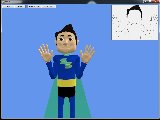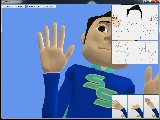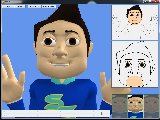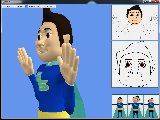Computer Animation of American Sign Language (independent study) (Purdue CS 590)
An independent study course I took during my third semester and that I'm continuing right now, although not for credits.
This is part of a group of ongoing projects that looks to provide educators with tools to author deaf-accessible math and science digital learning materials for grades 1-3. An important part of the project is to be able to produce expressive ASL animations without having to learn complicated animation tools (such as Maya or 3D Max).
My work focused on improving the interface for posing the signing character. The program already had the functionality to modify joints, and I added the functionality to be able to modify the model's face features to create expressions by manipulating a set of 39 morph targets. I also modified the camera to automatically zoom into the selected joint or face feature, and worked on fixing several bugs and small functionality changes. This was implemented using XNA 3.1.
I'm currently working on creating and applying a user study to evaluate the design principles the GUI is based upon.
Below are some screenshots of the project (click to enlarge).
This is part of a group of ongoing projects that looks to provide educators with tools to author deaf-accessible math and science digital learning materials for grades 1-3. An important part of the project is to be able to produce expressive ASL animations without having to learn complicated animation tools (such as Maya or 3D Max).
My work focused on improving the interface for posing the signing character. The program already had the functionality to modify joints, and I added the functionality to be able to modify the model's face features to create expressions by manipulating a set of 39 morph targets. I also modified the camera to automatically zoom into the selected joint or face feature, and worked on fixing several bugs and small functionality changes. This was implemented using XNA 3.1.
I'm currently working on creating and applying a user study to evaluate the design principles the GUI is based upon.
Below are some screenshots of the project (click to enlarge).
 |
 |
 |
 |